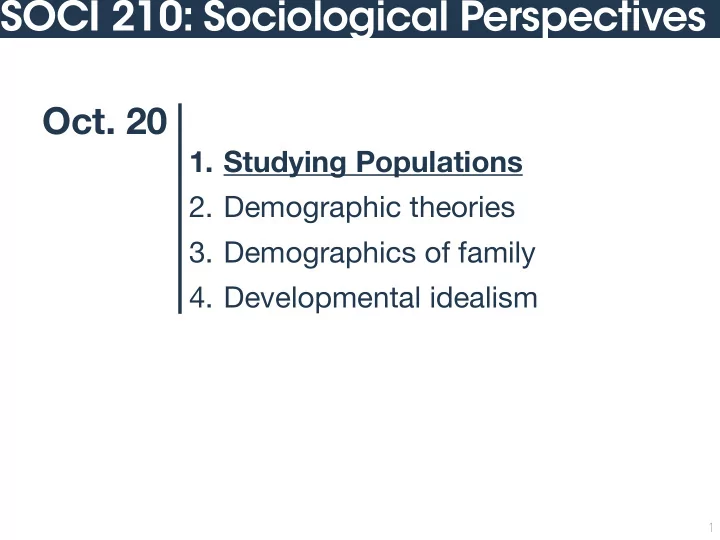

SOCI 210: Sociological Perspectives Oct. 20 1. Studying Populations 2. Demographic theories 3. Demographics of family 4. Developmental idealism 1
Studying Populations 2
Studying populations Demography Characteristics of a population ⦙ Study of populations at a macro- ⦙ Overall size scale ⦙ Proportions of socially relevant ⦙ At its most basic: understanding the categories Ethnicity, gender, religion, etc. ways populations grow, shrink, and otherwise change ⦙ Rates of change in these populations ⦙ Relationship between population and other sociological factors ⦙ Mechanisms of change in these populations 3
Studying populations Three factors a ff ect changes in population size: • Crude birth rate Birth Number of children born in a given time period, per 1,000 population • Fertility rate Average number of children that a woman would have over her lifetime, assuming current rates by age Death • Crude death rate Number of deaths in a given time period per 1,000 population • Age- and sex-specific mortality rates E.g. infant mortality (number of children who die within a year of birth, per 1,000 live births) Migration • Immigration versus emigration Immigration is migration into a country, emigration is migration out of a country • Net number of migrants Immigrants minus emigrants 4
Studying populations Total growth rate • Total rate of change over a time period Positive or negative Total growth = (Birth) – (Death) + (Migration) 5
Studying populations Population change Canada 2016–17 37.0 mil Deaths: 276,649 36.7 mil Net migration: 360,358 Births: 376,291 36.4 mil 2016 2017 6
Studying populations Population pyramids ⦙ Ubiquitous visual tool in demography ⦙ Picture of the ‘shape’ of an entire population ⦙ Shows size of a population at di ff erent ages age ⦙ Can compare sub-populations on right and left (traditionally gender binary) 7
Studying populations 8
Studying populations Source: Pew Research Center 9
Studying populations Source: University of Ottowa (2001) 10
Global patterns Fertility Niger 7 Somalia Democratic Republic of the Congo Mali Chad Burundi 6 Angola Uganda Timor-Leste Nigeria Burkina Faso Gambia Mozambique Afghanistan United Republic of Tanzania Benin Zambia South Sudan Côte d'Ivoire Central African RepublicGuinea Senegal Equatorial Guinea 5 Cameroon Guinea-Bissau Mauritania Congo Malawi Liberia Sierra Leone Sudan Togo Sao Tome and Principe Ethiopia Comoros Iraq Madagascar Eritrea Yemen State of Palestine Rwanda Ghana Samoa Mayotte Kenya Solomon Islands Zimbabwe 4 Gabon Papua New Guinea Tonga Kiribati Pakistan Namibia Jordan Tajikistan French Guiana Vanuatu Egypt Micronesia (Fed. States of) Swaziland Lesotho Guatemala Kyrgyzstan Haiti Djibouti Syrian Arab Republic Lao Philippines Bolivia (Plurinational State of) Israel 3 Turkmenistan Algeria People's Democratic Republic Oman Botswana Mongolia Saudi Arabia Cambodia Kazakhstan Honduras Belize Fiji Guyana Paraguay Western Sahara Panama Ecuador Morocco Dominican Republic South Africa Cabo Verde Peru Suriname Indonesia India Guam Libya Venezuela (Bolivarian Republic of) Réunion Seychelles Uzbekistan Argentina Nicaragua Nepal United States Virgin Islands Myanmar Mexico Tunisia New Caledonia Bangladesh Maldives Bhutan Grenada El Salvador Malaysia Turkey Antigua and Barbuda Bahrain Azerbaijan Sri Lanka French Polynesia Curaçao Jamaica Uruguay Kuwait New Zealand Saint Vincent and the Grenadines Guadeloupe Georgia Qatar Ireland 2 Iceland France Martinique Dem. People's Republic of Korea Viet Nam Colombia Brunei Darussalam Sweden United Kingdom Australia United States of America Costa Rica Norway Trinidad and Tobago United Arab Emirates Chile Aruba Bahamas Barbados Belgium Iran (Islamic Republic of)Brazil Finland Montenegro Denmark Netherlands Albania Lebanon Cuba Russian Federation Canada Armenia Belarus China Estonia Lithuania Serbia Slovenia Luxembourg Switzerland Thailand Puerto Rico Bulgaria Saint Lucia Mauritius TFYR Macedonia Latvia Croatia Ukraine Czechia Romania Channel Islands Austria Italy Germany Japan Malta Cyprus Slovakia Hungary Greece Spain Bosnia and Herzegovina Poland Republic of Moldova Portugal Singapore Republic of Korea China, Hong Kong SAR China, Macao SAR China, Taiwan Province of China 1 100 thousand 1 million 10 million 100 million 1 billion Population Population Source: United Nations Population Division 11
Global patterns Population of Canada 35 mil. 30 mil. 25 mil. 20 mil. 15 mil. 1950 1960 1970 1980 1990 2000 2010 Year Source: United Nations Population Division 12
Recommend
More recommend